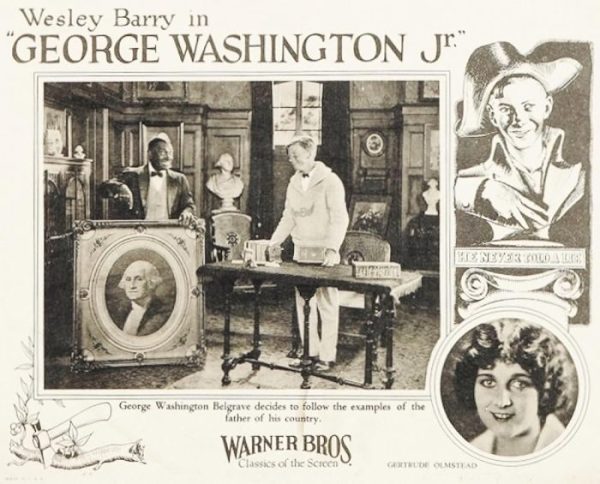IMDb
Flick Friday: The Heart Of Wetona 1919

One hundred, five years ago, today, the silent, adventure film The Heart Of Wetona was released. Directed by Sidney Franklin, it was written by Mary Murillo, basing it on a theatrical work by George Scarborough. Produced by Joseph M. Schenck, it starred Norma Talmadge (as Wetona), Fred Huntley, Thomas Meighan, Gladden James, F. A. Turner and Charles Edler.
“After the half-breed daughter of a Comanche Chief falls for a young engineer who deserts her, she turns to a white Indian agent who marries her.”
IMDb Short
“Wetona, the daughter of Indian Chief Quannah and a white mother, returns to her tribe after an education in a white school in the East, [only] to find herself torn between the two cultures of her heritage.”
IMDb Storyline
“The film tells the story of some Comanche Indians and their preparations for a Corn Dance. The father of Wetona finds out she loves a white man.
Wikipedia Plot
♦ Heart Of Wetona (World War One era song, sung by Wetona’s soldier)
Complete Movie
Flick Friday: Friday The Thirteenth 1933

I got lucky, today and found a Friday The 13th movie that had nothing to do with Jason or Camp Crystal Lake. Ninety years, ago, Friday The Thirteenth was released in the UK, at some point in November of 1933. The movie opened in New York on May 14, 1934. Curiously, this movie seems more science-fiction than spook. ~Vic
Directed by Victor Saville, produced by Michael Balcon and written by Sidney Gilliat, George Moresby-White, & Emlyn Williams, it starred Jessie Matthews, Sonnie Hale, Muriel Aked, Cyril Smith, Richard Hulton, Max Miller and, Alfred Drayton.
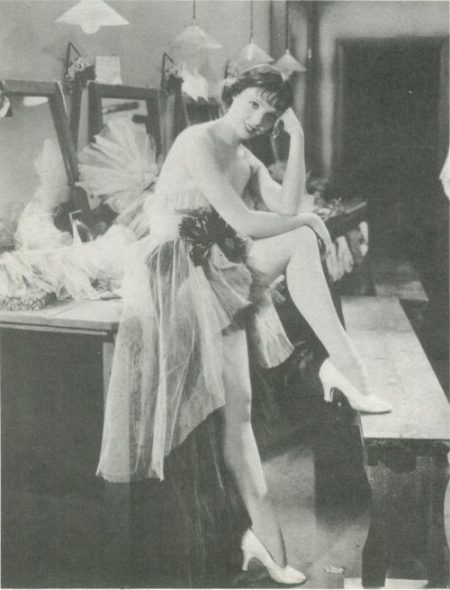
Photo Credit: IMDb & Amazon
It is pouring with rain at one minute to midnight on Friday the thirteenth and the driver of a London bus is peering through his blurred windshield as his vehicle sails down an empty road. Suddenly, lightning strikes and a vast crane above topples into the path of the oncoming bus. Then, Big Ben begins to wind backwards. Time recedes and we discover the lives of all of the passengers, and the events that brought them to that late-night bus journey, from the con man with a hundred pound cheque to the businessman’s distraught elderly wife. Time flows on, inevitably, to the crash and past it, as some live and some die.
IMDb Storyline
The complicated lives of twelve people travelling on a bus are traced up to the point when the bus crashes into a shop, killing two of the passengers.
BFI Screen Online
In London, near midnight, as a rain storm rages, several people travel across the city on a bus. Of the passengers, one elderly woman seems anxious and upset, a young man who has just been robbed by a pickpocket gratefully accepts money for his fare from another passenger, another man boasts of his knowledge of art, and a young woman angrily destroys a photo of a man. When a lightning strike causes the bus to crash, each passenger recalls what brought them on the ill-fated journey.
Rotten Tomatoes Movie Info
After a London bus crash leaves two people dead and several injured, the clock is turned back twenty-four hours to show the lives of the bus passengers, how they happened to be on that bus at that time, and the effect of the crash upon their lives.
TCM/AFI Synopsis
♦ AllMovie Synopsis (Hal Erickson)
♦ Review: Friday The Thirteenth (1933) (Comet Over Hollywood/Jessica Pickens/April 13, 2018)
You can watch the entire movie on the Internet Archive HERE.
TV Tuesday: The Queen Street Gang 1968

Fifty-five years, ago, today, the British, Thames Television TV show The Queen Street Gang was released. There were nine episodes from Aug. 1 to Sep. 26. Directors were Nicholas Ferguson and Adrian Cooper. Writers were Roy Russell and Desmond Skirrow. The main cast was Sebastian Abineri (Big Bill), Liz Crowther (Phillipa), Len Jones (Sniffer), Anthony Peplow (Speedy), Michael Feldman (Mini Morris), Michael Gwynn (Professor Morris) and Maureen O’Reilly (Mrs. Morris).
Comedy drama series. A group of kids manage to get involved in adventures with spies and the like.
IMDb Storyline
Well trained, highly organised and working from a secret H.Q., The Queen Street Gang were, undoubtedly, an attempt by Thames television to create a modern day Famous Five. There were even comparisons to be drawn with the Enid Blyton created characters, including one of the children being the daughter of a top secret researcher. The series was based on a 1966 children’s adventure book called The Case of the Silver Egg by Desmond Skirrow and adapted for TV by Roy Russell. The first of the two stories made involved a silver egg that was able to hold all the electricity in the world, which was then stolen by a group of criminals […]. It was up to the gang to recover it, rescue the kidnapped professor and make the world a safer place for us all.
Television Heaven UK
Noel Onely
January 24, 2019
This series is believed lost. ~Vic
The Queen Street Gang (Nostalgia Central)
Flick Friday: [The] Forbidden Lover 1923

One hundred years, ago, today, the black & white silent film [The] Forbidden Lover was released. Brackets around “THE” is a product of the differences of the title from data sources. This film is an edited version of The Power of Love, the very first 3-D movie, released on September 27, 1922 at the Ambassador Hotel Theater in Los Angeles. Both films are believed lost.
Directed by Nat G. Deverich and, written by Kate Corbaley & Caroline Crawford, it starred Elliot Sparling, Barbara Bedford, Noah Beery, Aileen Manning, Albert Prisco and John Herdman.
Yankee sea captain lands on the coast during the old Spanish days to trade with the ranch owners. He meets a girl who is betrothed to a man she loathes. After a series of adventures and narrow escapes, he shows up the unscrupulous ranch owner and wins the girl.
IMDb [The] Forbidden Lover Storyline
Motion Picture News Booking Guide
October 1923
Production Company: Sierra Productions
Tagline: A Romance Of Early California
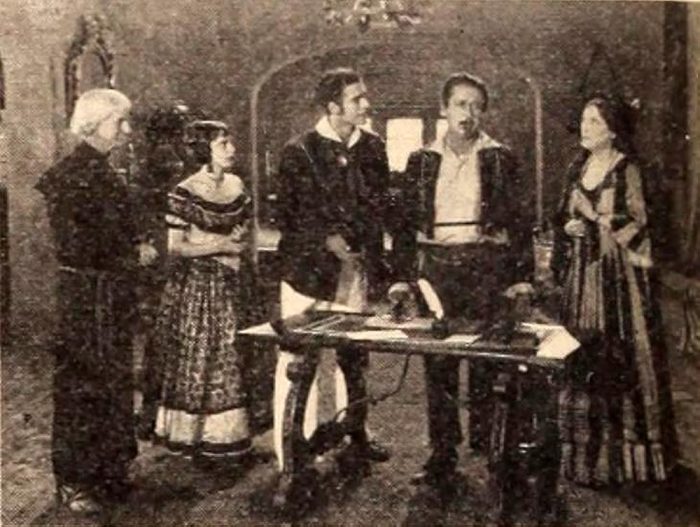
The Power Of Love
Image Credit: IMDb & Amazon
Because of his financial trouble, Don Almeda promises his daughter, Maria, to Don Alvarez but, Maria does not love [him]. In fact, she falls in love with Terry O’Neil, a stranger who has been wounded by robbers associated with Alvarez. O’Neil takes Alvarez’s place at a masked ball. Alvarez, in turn, robs the old Padre of some pearls and stabs him to death with O’Neil’s knife. He then accuses O’Neil of the murder and tries to shoot him but, wounds Maria instead, having thrown herself in front of him. Maria recovers and, after proving that Alvarez is a thief and a killer, weds O’Neil.
IMDb The Power of Love Storyline
Moving Picture World
October 1922
Production Company: Perfect Pictures
Tagline: A pair of spectacles will be handed to you as you enter the theatre, through which you will view the new sterescopic pictures.
The Power of Love was screened in front of a live audience at the Ambassador Hotel Theater […]. It was projected dual-strip in the red/green anaglyph format, making it both the earliest known film that utilized dual strip projection and the earliest known film in which anaglyph glasses were used. The camera rig used to shoot the film was made by the producers themselves and as you can imagine, it was far from perfect. Simply put, the film was not a success. It was screened, again, for exhibitors, and press, in New York City and, then, almost immediately fell out of sight. It was not booked again by other exhibitors. Unfortunately, we may never see what this movie looked like.
3-D TV & Movies
The first stereoscopic image dates to 1844, which makes 3-D images as old as the art of photography. [No] less a personage than Queen Victoria was photographed in 1854 in stereoscopic 3-D. 3-D stereoscopic moving images date to the 1850s with what was called the Kinetamatoscope [sic]. The first public display of a 3-D movie came in 1922 with The Power of Love […]. The film received a decent review in Moving Pictures World, then promptly disappeared from history by changing its title to Forbidden Lover and touring the country in a 2-D version. It was too complex and costly at the time to take 3-D on the road.
Randome
Looking Up/My Daily Plant Blogspot (Blogger)
Cirque de 3-D
March 6, 2009
What Was The First 3D Movie? (3D TV & Movies/Web Archive/06-02-2011)
A Tour Through The History Of 3-D Movies (Reelz/Jeff Otto/01-22-2009/Web Archive/07-20-2012)
Forbidden Lover (Silent Era/06-08-2013)
The Power of Love (Silent Era/10-16-2011)
Forbidden Lover (TCM)
The Forbidden Lover (AFI Catalog)
The Power of Love (AFI Catalog)
The Shot Of The Year (The Dissolve/Calum Marsh/12-19-2014)
Flick Friday: To Hell With The Kaiser! 1918
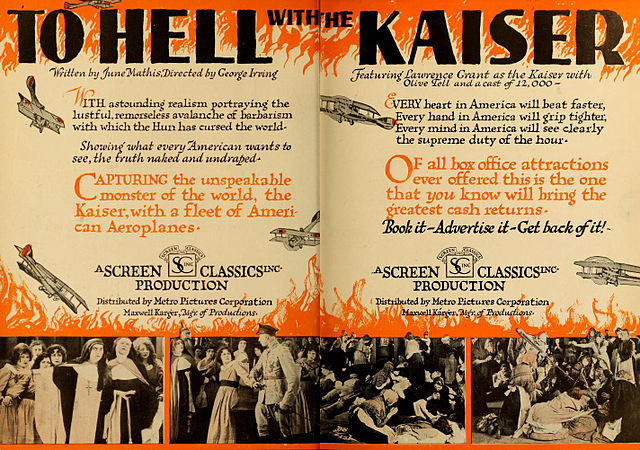
Source: Archive Image
Author: Metro Pictures/Screen Classics, Inc.
One-hundred, five years, ago, today…the silent black & white, comedy-drama To Hell With The Kaiser! was released. Written by June Mathis and directed by George Irving, it starred Lawrence Grant (as The Kaiser/actor Robert Graubel), Olive Tell, Betty Howe, John Sunderland, Earl Schenck (as the Crown Prince), Mabel Wright, Frank Currier, Karl Dane and Walter P. Lewis as Satan.
Following the death of his father, Frederick III of Germany, Wilhelm Hohenzollern becomes the German Kaiser and forms a pact with the devil that, he will conquer the globe in exchange for his soul. During the Kaiser’s invasion of Belgium, the Crown Prince enters a church and rapes Ruth Monroe, the daughter of an American inventor who has perfected a noiseless communications device. When the professor denounces the Crown Prince, he immediately is shot, whereupon his other daughter Alice vows to obtain revenge. While Alice’s sweetheart, Winslow Dodge, fights with the Americans as an aviator, she arranges to meet the Crown Prince through her friend Robert Graubel, an actor who impersonates the Kaiser at public functions. With her father’s wireless [device], Alice informs Winslow of the Kaiser’s whereabouts and, as he captures the German emperor, she kills the Crown Prince. Now a prisoner, the Kaiser drowns himself and wakes up in Hell, where Satan abdicates in his favor, saying that the Kaiser’s tortures are more fiendish than any he ever devised.
IMDb Storyline

Lobby Poster
IMDb & Amazon
Lawrence Grant, who spent his lengthy career playing odious villains, appeared in the dual role of Kaiser Wilhelm II and his look-alike, German actor Robert Graubel. Terrified of being assassinated, the Kaiser hires Graubel to impersonate him at various political functions. In the film, the Kaiser achieves military success through an infernal pact with Satan. Once this is established, the film concentrates on the seemingly endless tally of misdeeds perpetrated by the Kaiser during his quarter-century reign over Germany. His “partner in crime” is the Crown Prince […], who thinks nothing of casually raping convent girls and gunning down protesting nuns. The Crown Prince’s latest conquest is Ruth Monroe […], the daughter of an American inventor. When Ruth’s father protests this outrage, he is brutally murdered, whereupon Ruth’s sister Alice […] vows revenge. Using her father’s newest invention, a wireless machine whose coded messages cannot be intercepted, Alice directs a battalion of planes to bomb the small German village where the Kaiser is hiding. Captured by the Allies, the Kaiser is ignominiously dumped in a POW camp but, not before enduring a well-aimed sock on the jaw from a pugnacious dough-boy. In despair, the Kaiser commits suicide and sends his soul to hell. In hell, the devil […] gives up his throne, confessing that the Kaiser is far more sinister than he could ever hope to be.
[On June 8, 1918], Motography ran a Screen Classics press release explaining that To Hell With The Kaiser “reveals the machinations of Europe’s military monster before and during the war, his contempt for Americans […], his elaborate plans to crush France, […] destroy Russia, […] partition the world, […] his [order] to employ deadly gases in the war, the true circumstances under which he ordered the sinking of the Lusitania, the raiding of hospitals […].” Years before the war, Mr. Grant’s physical likeness to the German ruler was noted by a high official of the Kaiser’s court and a proposition was made for Grant to play the Kaiser in a dramatization […]. The war broke out before discussions went any further.
Actor John Sunderland, playing American pilot Winslow Dodge, was himself “an aviator who has seen service in Belgium.”
[It] had been released in the press that Kaiser Wilhelm II had half a dozen doubles who were employed to pose for him in various parts of the country, where there might be danger of assassination, while the real Kaiser, himself, remained safe behind this cloak.
To Hell With The Kaiser opened in New York City at the Broadway Theatre on June 30, 1918, immediately after it had emerged from the cutting and editing rooms […].
The film turned out to be an effective propaganda tool […]. Not only has the picture been shown in munitions plants and training camps […] but, this power has now been demonstrated in a new way…to convert conscientious objectors.
The National Film Preservation Board (NFPB) included this film on its list of Lost U.S. Silent Feature Films as of February 2021.
I found the building of this post fascinating. What started out as a simple movie post, turned into a history lesson. It’s a shame that it is lost. There are photographs of still pictures on IMDb. ~Vic
Music Monday: When Irish Eyes Are Smiling 1913

Image Credit: Knick Of Time Blog
One-hundred, ten years ago…
When Irish Eyes Are Smiling is a lighthearted song in tribute to Ireland and was very popular in June 1913. Its lyrics were written by Chauncey Olcott and George Graff, Jr., set to music composed by Ernest Ball, for Olcott’s production of The Isle O’ Dreams and, Olcott sang the song in the show. It was first published in 1912, at a time when songs in tribute to a romanticised Ireland were very numerous […], both in Britain and the United States. During the First World War, the famous tenor John McCormack recorded the song.
The song continued to be a familiar standard for generations. Decades later, it was used as the opening song on the radio show Duffy’s Tavern. The song has been recorded on over 200 singles and albums, by many famous singers, including Bing Crosby, Connie Francis and Roger Whittaker.
Wikipedia Summary
As I have stated in previous posts, Billboard’s charting abilities, in the early 20th Century, is difficult to navigate. My first stop, for these early pieces, is the Tsort site. Playback FM is very helpful, too. Digging around in the Wayback Machine can be a complete rat maze. The data is there but, how much time do you devote to searching for it.
There was a Shamrock Summit in March 1985, apparently, in Canada (which I don’t remember). Starting on St. Patrick’s Day, Prime Minister Brian Mulroney and President Ronald Reagan met & talked for two days. Remember the Acid Rain Scare back then? It was seen as a Turning Point in U.S.-Canada Relations (both Trudeaus don’t play well with others?) and the closing ceremonies were televised, with the men & their wives singing the song (Mulroney & Reagan are Irish surnames). I find the meeting in Quebec City and the singing of an Irish song, ironic and amusing. ~ Vic
Additional:
♦ Irish Eyes Are Smiling (The Account of Composer Ernest R. Ball’s Life/IMDb/1944)
♦ Still Something To Smile About (Pocono Record/Marta Gouger/Wayback Machine/03-06-2007)
♦ When Irish Eyes Are Smiling (Irish Music Daily/Pat/No Date Given)
♦ List Of Movies Using The Song
TV Tuesday: Wisden Trophy 1963
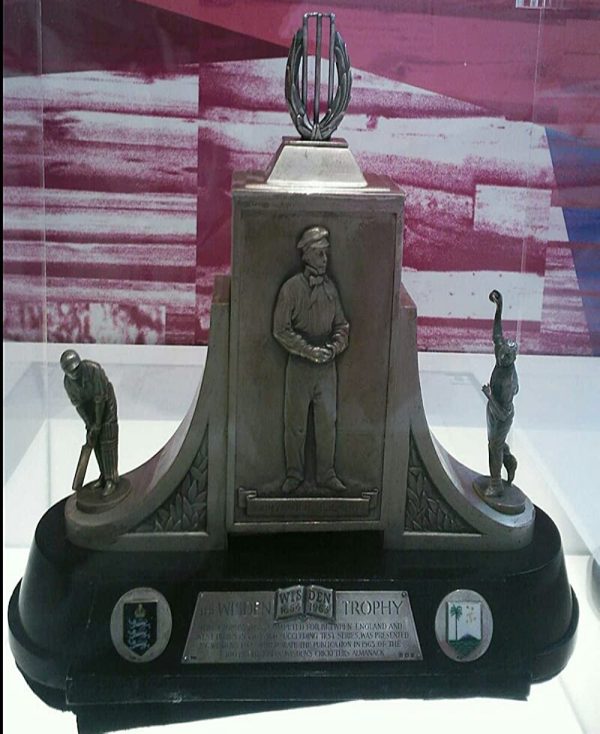
Sixty years, ago, today, the British TV Series Wisden Trophy debuted.
The trophy is named after the famous cricketing publisher Wisden and was presented by John Wisden & Co. after gaining the approval of the Marylebone Cricket Club (MCC) and the West Indies Cricket Board (WICB). The [trophy] was presented to the victorious team as a symbol of its victory but, then, returned to the MCC Museum at Lord’s.
The [trophy was] awarded to the winner of the Test cricket series, played between England and the West Indies. It was first awarded in 1963 to commemorate the hundredth edition of Wisden Cricketers’ Almanack. Series were played in accordance with the future tours programme, with varying lengths of time between tours. If a series was drawn, then, the country holding the [trophy] retained it. In 2020, it was announced that the trophy would be replaced by the Richards–Botham Trophy, named after Sir Vivian Richards and Sir Ian Botham.
Wikipedia Summary
The list of “cast members” consisted of various cricketers hosting the show. Brian Lara had the most appearances (34), with Garry Sobers, Rohan Kanhai and Micky Stewart hosting the first episode.
I have to confess that I know squat about cricketing. ~Vic
TV Tuesday: A Good Idea, Son! 1953

Seventy years, ago, today, the TV Special A Good Idea, Son! aired on BBC at 9:30pm. A musical comedy, written by Eric Sykes, it starred Max Bygraves (host & presenter), Belita (The Ice Maiden), Bob Dixon (pianist), the George Mitchell Singers, Peter Glover, The King Brothers, Lillemor Knudsen and Jean Marsh. It was an hour long program in black & white. There are no pictures from the show but, I did manage to find a short YouTube clip of Max Bygraves singing the title song. Bygraves is also associated with the Educating Archie Radio Show. As with many early television shows, there is not much written about it. ~Vic
Additional:
♦ A Good Idea, Son! (British Comedy Guide)
♦ Max Bygraves (Evening Standard/09-01-2012)
♦ Eric Sykes In His Own Words (BBC News/07-04-2012)
♦ Educating Archie (Vinny’s Mislaid Comedy Heroes)
♦ Educating Archie (Vintage Comedy Corner)
TV Tuesday: Stage Door 1948
Yes, I am still alive. I took a break for health reasons. ~Vic

Seventy-five years, ago, today, the TV movie Stage Door aired. The information on this movie is limited but, there is a record of it in the IMDb. Based on a 1936 stage play, written by Edna Ferber and George S. Kaufman…
[It is] about a group of struggling actresses who room at the Footlights Club, a fictitious theatrical boardinghouse in New York City, modeled after the real-life Rehearsal Club. The three-act comedy opened on Broadway on October 22, 1936, at the Music Box Theatre and ran for 169 performances. The play was adapted into the 1937 film of the same name and was also adapted for television.
Wikipedia Summary
Directed by Ed Sobol, it starred Louisa Horton, Harvey Stephens, Mary Anderson, John Forsythe, Enid Markey and Mary Alice Moore. It was an hour & 30 minutes long and there is no indication as to which network carried it. The 1937 film adaption starred Katharine Hepburn, Ginger Rogers and Lucille Ball.
An additional one-hour television adaption aired on CBS in April of 1955. There are plenty of clips on YouTube from the 1937 movie but, nothing from either television version.
Movie Monday: The Princess In The Vase 1908

One-hundred, fifteen years ago, today, the short, silent black & white comedy The Princess In The Vase was released. Directed by Wallace McCutcheon, Sr., it starred only three actors…D.W. Griffith, Edward Dillon and Linda Arvidson, Griffith’s then-wife. Griffith is the Lover, Arvidson is the Lady-in-Waiting and Dillon is the Waiter. C. W. “Billy” Bitzer was the cinematographer.
The opening scenes of this production are laid in Egypt, five hundred years before Herodotus, the Father of History, visited that country. Three thousand years ago, there dwelt in Egyptian Memphis, the ancient capital of the Pharaohs, a wealthy prince, whose wife in beauty was likened to [Hathor], the Egyptian Venus, with [a] heart as cold as Egyptian marble. The prince, worried and suspicious, seeks the royal seer, who tells him the princess has a lover and, in a vision, shows him the princess in the arms of that lover, a Theban warrior. Instant death is the punishment meted out to the guilty pair. The princess is placed on a bier and carried out in front of the Temple, under the very shadow of the Pyramids of Gizah. Here, the High Priest, with a flambeau, sets fire to the pyre and her body is burned as an offering, with prayers, to mighty Osiris, beseeching that he overcome Typhon, who seems to hold sway. Alongside the pyre is placed a vase, decorated with hieroglyphics, which is to be the sarcophagus, of that ethereal, of the unfortunate princess. The smoke and vapor, as it arises from the body, enters the vase in a most mysterious manner. The vase is then sealed and the cavalcade proceeds with it to the tomb, where it is deposited and the door of the tomb closed, it was thought forever. Three thousand years later, there came to the “Land of Ruins” a Boston professor, student of the illustrious Jean Francois Chainpollion, discoverer of the key to Egyptian hieroglyphics, who unearthed the vase and took it to his home in Boston. Vague, indeed, was the story he learned about the treasure and, while sitting in his study, cudgeling his brain to lift the veil of mystery from it, falls to sleep. [In] this psychological condition, [he] imagines the maid, while dusting, knocks the vase from the tabouret on which it stands. Bursting into bits, it emits a dense vapor, from which the reincarnated princess appears. Here is trouble. Our friend, the professor, is a married man, whose better-half is a buxom, unethereal person, who doesn’t believe in the “Soul Sister” tommyrot. She, of course, wants an explanation, which the nervous professor is unable to give, so he bolts and runs hatless out of the house, followed by the princess, both followed by Mrs. Professor. Into a restaurant he rushes, with the princess at his heels. At the restaurant, as they sit enjoying a repast, the reincarnated Theban lover appears and claims the princess. This, the old professor resents and is run through by the Egyptian just as the wife enters. Mortally wounded, he falls to the floor, from the sofa, [as] the scene changes and we find the professor awakening from a horrible dream, the pain of the sword thrust being induced by a severe attack of indigestion.
There are no videos of this or any pictures. Since the movie was about a Princess, I grabbed a photo of Linda Arvidson from her IMDb profile. She also has a nice picture on Wikipedia, linked, above. The film is listed for 1908 releases and there is a note/citation referencing a mention of this short in Horror In Silent Films: A Filmography 1896-1929, though IMDb does not tag this as a horror. The production company was American Mutoscope & Biograph Company, the first company in the US devoted entirely to film production and exhibition. There is a survival status of some print in the Library of Congress. I wish I had more. ~Vic
NOTD: Biting Drink Cans

A Czech Republic man showed off his powerful jaws by biting 36 drink cans in half in one minute, earning a Guinness World Record.
René Richter, appearing on Italy’s Lo Show Dei Record, took on the Guinness World Record for most drink cans ripped in half with the teeth in one minute.
The aluminum cans were filled with water for the attempt and Richter was allowed to use only one hand, and his teeth, for each can. [He] chomped through 36 cans in the allotted time, successfully setting the record.
Ben Hooper
UPI Odd News
January 11, 2023
This guy makes my teeth hurt. ~Vic
News of the Day
TV Tuesday: Friday The 13th 1957

Sixty-five years ago, today, the British comedy Friday the 13th aired on BBC1. There is very little information on this thirty minute broadcast. It’s simple storyline states:
Ted Ray presents a lighthearted look at superstitions.
Written by John Junkin and Terry Nation, produced by George Inns, the only cast listed is Ted Ray and June Whitfield. IMDb states that it was shown in black & white. The British Comedy Guide reflects “colour.” As best as I can tell, it aired at 7:30pm and it definitely was on a Friday the 13th.
I love British comedy. I wish I could find a YouTube clip or some still photographs. There is just nothing, other than a vague Internet memory of its existence. ~Vic
